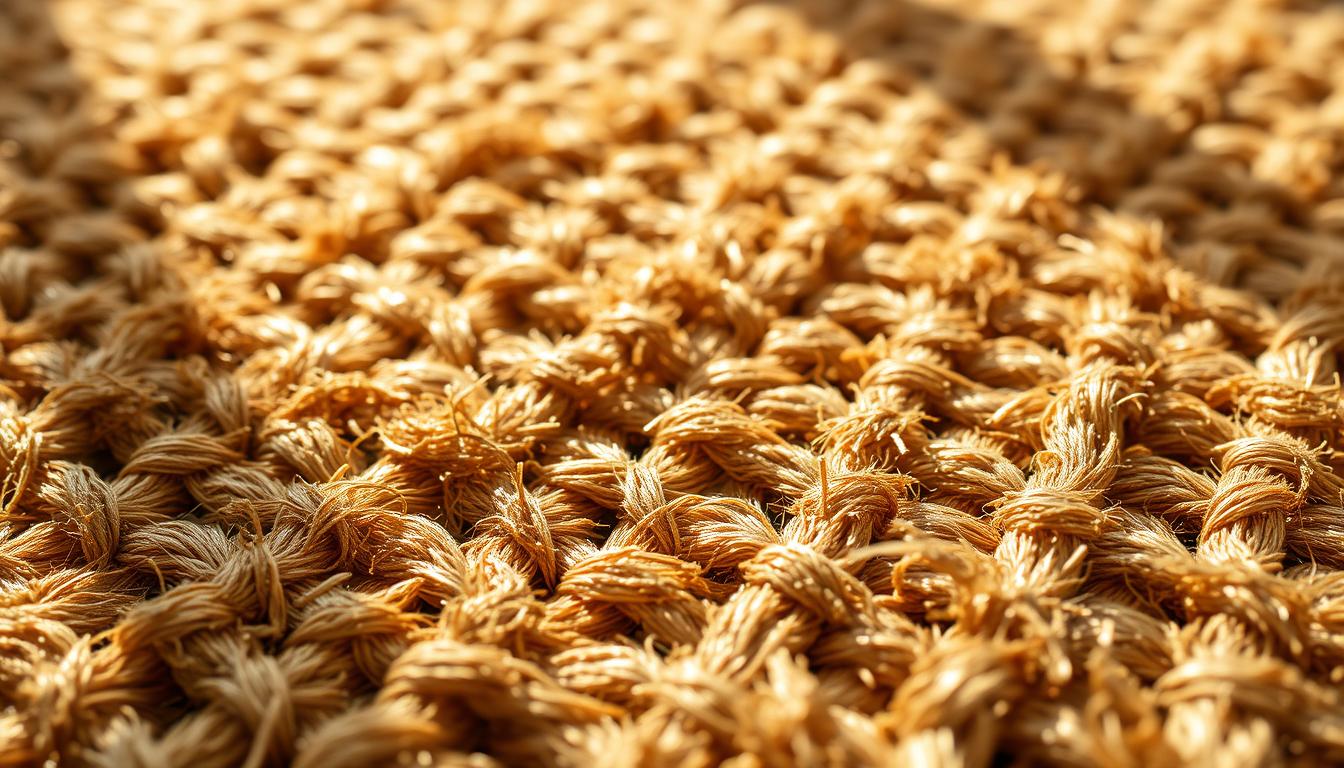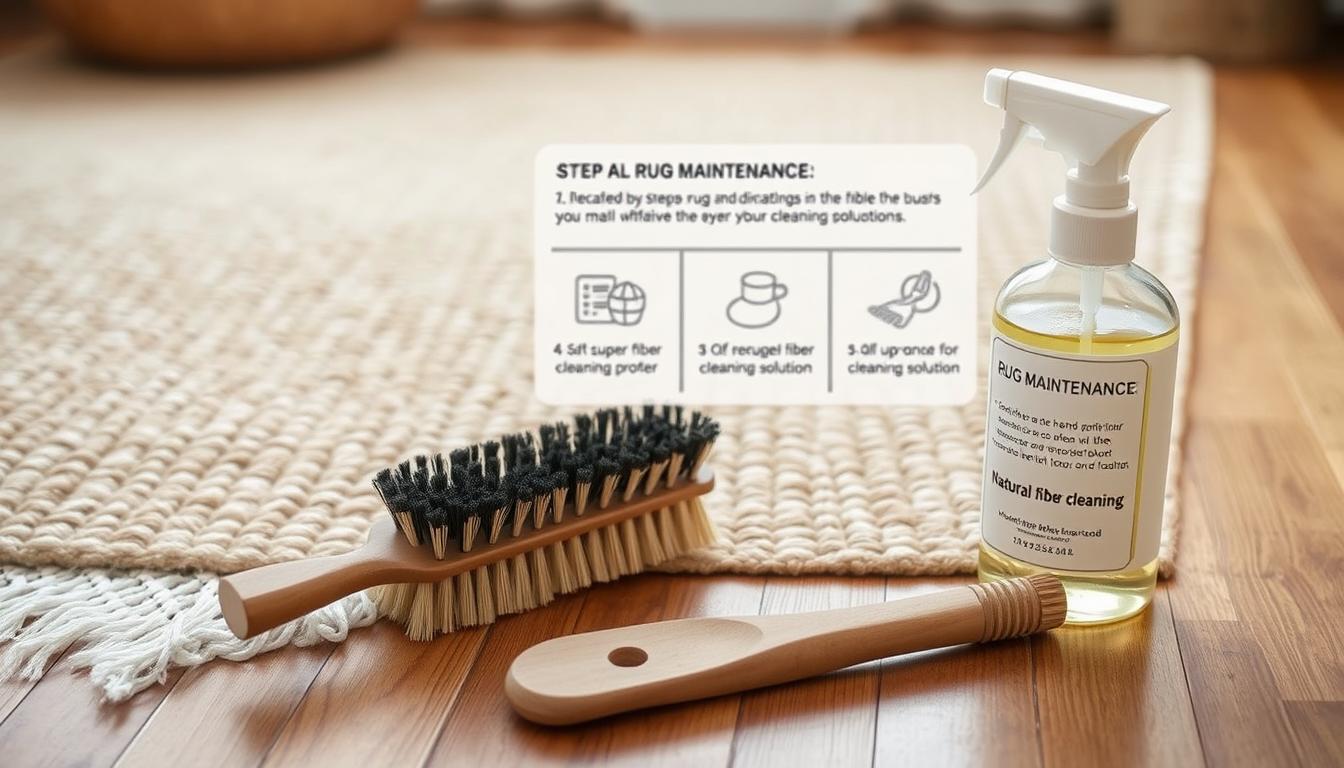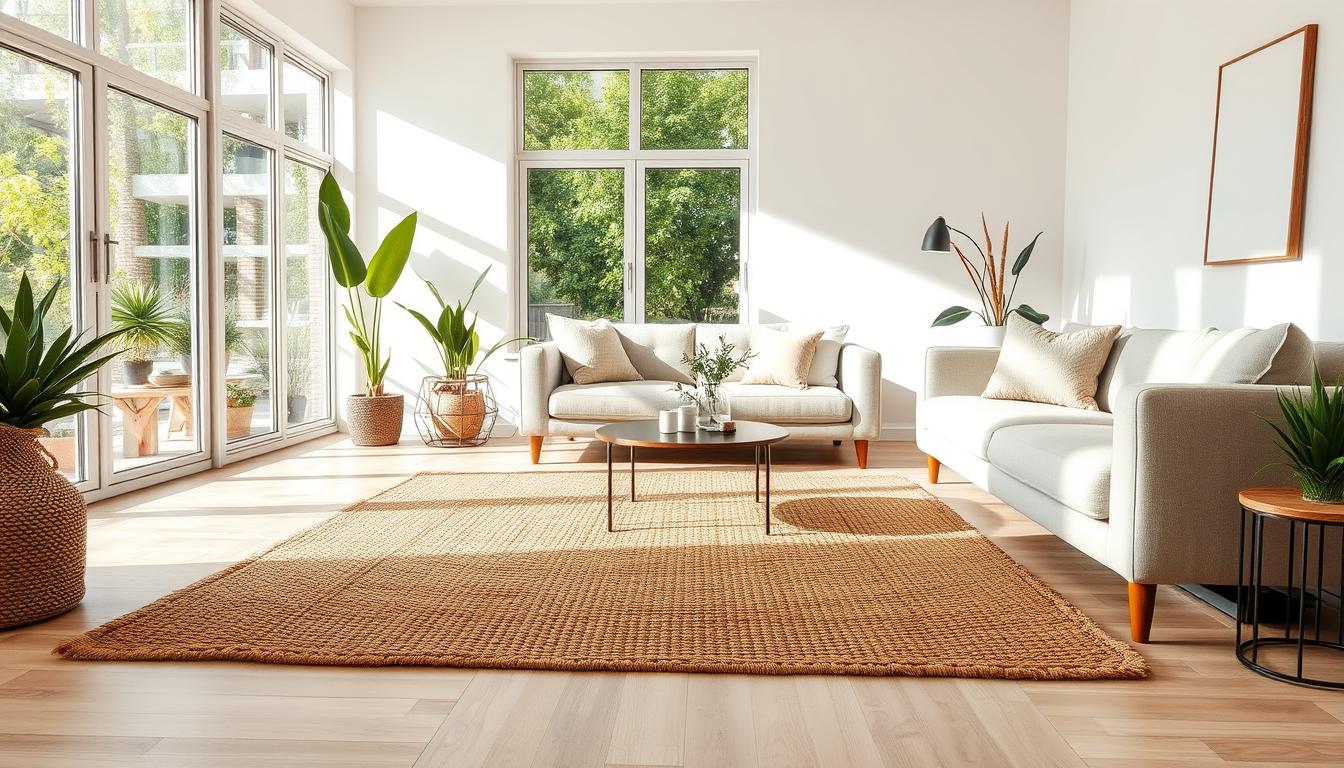
5 Clear Facts About What Jute Rugs Are Made Of
Could your floor covering secretly be one of Earth’s most sustainable treasures? The answer lies in a humble plant that transforms living spaces while leaving minimal environmental impact.

Derived from the Corchorus plant, this natural wonder thrives in tropical regions like India and Bangladesh. Farmers harvest tall stalks bursting with fibrous potential, then carefully process them into durable strands. Known as the "golden fiber" for its warm hue, this material requires 90% less water than cotton to cultivate.
Workers separate the plant’s outer bark through a water-soaking technique called retting. Sun-dried fibers gain their signature strength and earthy glow before skilled artisans weave them into floor coverings. These textured home accents combine rustic charm with modern eco-conscious appeal.
Second only to cotton in global production, this renewable resource grows rapidly without synthetic fertilizers. Its biodegradability means your flooring choice won’t linger in landfills for centuries. Discover how nature’s golden gift becomes a functional art piece underfoot.
Key Takeaways
- Originates from fast-growing Corchorus plants in South Asia
- Earns "golden fiber" nickname from natural color and shine
- Requires minimal water compared to cotton cultivation
- Biodegradable material supports eco-friendly lifestyles
- Artisanal weaving preserves traditional craftsmanship
- Accounts for 85% of global production in two countries
Introduction to Jute Rugs and Their Eco Appeal
Eco-conscious homeowners are turning to a flooring solution that’s both stylish and sustainable. Jute rugs blend earthy textures with modern practicality, offering a guilt-free way to elevate your home decor. Designers praise these natural fiber pieces for their ability to soften minimalist spaces or add warmth to bohemian interiors.
Unlike plastic-based alternatives, jute cultivation leaves a lighter footprint. Farmers grow this renewable resource in nutrient-rich delta regions, harvesting stalks every 4-6 months.
"Jute’s rapid growth cycle makes it a hero material for sustainable design,"
notes Atlanta-based interior designer Mara Hernandez.
See how natural fibers outperform synthetic options:
| Features | Jute Rugs | Synthetic Rugs |
|---|---|---|
| Material Source | Plant-based | Petroleum derivatives |
| Environmental Impact | Biodegrades in 1-2 years | 500+ year decomposition |
| Cost per Sq Ft | $3-$8 | $5-$15 |
| Aesthetic Flexibility | Neutral base for layering | Limited texture options |
Homeowners love how these soft, earthy textures adapt to coastal, farmhouse, or contemporary themes. Their natural color variations hide everyday dust better than flat-weave synthetics, while the breathable fibers resist static buildup.
With 72% of US designers specifying sustainable materials in 2023 projects, jute’s star keeps rising. You get durable flooring that aligns with eco-values – without sacrificing style or breaking budgets.
What is a jute rug made of?
Beneath your feet lies a story of tropical plants transformed into home decor. The Corchorus species thrives in monsoon climates, growing 10-12 feet tall within four months. Farmers in Bangladesh and India harvest these towering stalks during peak summer months when fiber content reaches its highest quality.
Workers separate the plant's outer layer through natural water retting. This process releases long, silky strands that gain strength as they sun-dry. Artisans then spin these durable golden fibers into yarns ready for weaving.
Discover why this crop dominates global production:
| Growth Factor | Jute Plant | Cotton Plant |
|---|---|---|
| Annual Yield | 2.5-3 tons/acre | 1.5 tons/acre |
| Water Needs | Rain-fed | Heavy irrigation |
| Soil Enrichment | Improves fertility | Depletes nutrients |
| Carbon Absorption | 15 tons/hectare | 6 tons/hectare |
These renewable stalks become textured floor coverings through traditional hand-weaving methods. Unlike synthetic alternatives, the material maintains natural color variations that hide everyday wear. Its breathable structure resists static while allowing air circulation.
Second only to cotton in global textile use, this crop requires no chemical fertilizers. The plant's rapid regeneration cycle makes it a top choice for eco-conscious manufacturing. You get flooring that honors ancient craft traditions while supporting modern sustainability goals.
The Origin and Production Process of Jute Rugs
South Asia’s fertile river deltas nurture the raw materials beneath your feet. Tropical climates create ideal conditions for cultivating robust jute plants, which reach harvest readiness in just four months.

Harvesting and Retting of the Jute Plant
Farmers time their cuts precisely when stalks stand 10-12 feet tall. Harvested stems get bundled and soaked in ponds or rivers for 10-30 days. This water retting process breaks down pectin bonds, freeing silky fibers from woody cores.
Key growth milestones:
- Day 30: Seedlings reach 3 feet
- Day 75: Stalks develop maximum fiber density
- Day 120: Plants ready for cutting
Stripping, Spinning, and Weaving Techniques
Workers beat retted stems to separate fibers, then sun-dry them for natural bleaching. Traditional spinners twist strands into yarn using foot-powered wheels, while modern facilities employ mechanical carding machines.
Artisans choose weaving methods based on desired textures:
- Plain weave for casual durability
- Herringbone patterns for visual depth
- Diamond motifs using dyed accents
This production chain preserves centuries-old craft traditions while meeting contemporary eco-standards. You get rugs shaped by monsoon rains, tropical sunshine, and human ingenuity.
Benefits of Natural Jute Material for Home Décor
Natural fibers redefine home comfort when crafted into versatile floor coverings. Jute rugs bring unmatched durability to high-traffic areas, with tightly woven strands resisting fraying and wear. Their inherent strength comes from cellulose-rich fibers that naturally bond during weaving.
These earthy textiles act as thermal regulators, trapping warmth in winter and staying cool during summer months. Your energy bills may drop thanks to their insulating properties – a feature synthetic materials struggle to match. Breathable structures prevent moisture buildup, reducing allergy triggers while maintaining air quality.
The coarse texture of natural jute makes spills easier to manage than plush alternatives. Simply blot liquids quickly and vacuum weekly to maintain freshness. For stubborn spots, mild soap solutions revive surfaces without harsh chemicals.
Design flexibility shines through customizable options:
- Neutral tones blending with any color scheme
- Geometric patterns adding modern flair
- Ombré dyes creating depth in minimalist spaces
Manufacturers leverage jute’s pliability to craft soft, earthy textures in round, rectangular, or irregular shapes. From apartment studios to sprawling estates, these sustainable accents adapt effortlessly to your lifestyle while honoring planetary boundaries.
Eco-Friendliness and Sustainable Impact of Jute Rugs
Transforming your living space sustainably starts with materials that give back to the Earth. Jute rugs stand out as champions of circular design, returning nutrients to soil instead of lingering in landfills for centuries.
Farmers cultivate this crop with remarkable efficiency. Unlike resource-heavy textiles, jute thrives in tropical climates with natural rainfall and enriches farmland through its deep root system. A single acre absorbs 15 tons of carbon dioxide while producing 2.5 tons of usable fiber.
Compare eco-credentials of natural versus synthetic options:
| Feature | Jute | Synthetic Rugs |
|---|---|---|
| Decomposition | 1-2 years | 500+ years |
| Fertilizer Use | 70% less | Petroleum-based |
| Renewability | Annual crop | Fossil fuels |
These natural floor coverings complete their lifecycle responsibly. When worn out, they decompose fully without releasing microplastics – a stark contrast to nylon or polyester alternatives. Many homeowners choose jute rugs specifically for this closed-loop benefit.
Production practices amplify the environmental advantages. The plants naturally deter pests, reducing pesticide needs by 85% compared to cotton. Their rapid 120-day growth cycle allows multiple harvests without exhausting farmland.
For those prioritizing environmentally friendly solutions, jute offers measurable impact. Each purchase supports agricultural communities while keeping 30 square feet of synthetic materials out of landfills. Explore our in-depth guide to eco-friendly textiles to deepen your sustainable home journey.
Design Versatility and Aesthetic Appeal of Jute Rugs
Your living space gains instant character with floor coverings that shift effortlessly between design eras. Earthy neutrals in light beige and golden undertones create adaptable foundations for any palette. These natural hues reflect sunlight beautifully, brightening rooms while maintaining organic warmth.

"The magic lies in their texture – coarse enough to add depth but refined enough for formal settings."
This balance lets you layer bold furniture or artwork without visual competition. Coastal cottages gain breezy charm, while modern lofts achieve curated minimalism.
Three key advantages make these textiles design chameleons:
- Undyed surfaces catch light like natural linen
- Neutral bases harmonize with wood, metal, or stone accents
- Subtle grain patterns hide wear in high-traffic zones
Rooms feel larger thanks to the material’s airy look and light-reflective qualities. Pair them with velvet couches for contrast or match woven baskets for tonal cohesion. Their versatile color range adapts to seasonal changes – layer wool throws in winter or cotton runners in summer.
Maintenance aligns with busy lifestyles. Weekly vacuuming preserves the texture, while occasional rotation prevents sun fading. For those craving variety, reversible designs offer two styles in one piece. These floor solutions grow with your evolving decor, proving sustainability and style coexist beautifully.
Using Jute Rugs in Different Living Spaces
Transform every corner of your home with natural fiber solutions that balance style and practicality. Earth-toned floor coverings adapt seamlessly across functional zones, offering visual cohesion while serving distinct purposes in each area.
Ideal Applications for Living Rooms and Kitchens
Anchor your living room layout with textured pieces that define conversation zones. A 5x8 option under coffee tables creates tactile contrast against hardwood floors while reducing echo. These natural textiles handle foot traffic gracefully, maintaining their structure through daily use.
Kitchens benefit from easy-clean properties during cooking mishaps. Place runner-style options near sinks or stoves for slip resistance and quick spill management. Their natural color variations camouflage minor stains between cleanings.
| Space | Recommended Size | Key Benefit |
|---|---|---|
| Living Room | 8x10 | Defines seating areas |
| Kitchen | 2x6 Runner | Absorbs spills quickly |
| Dining Area | Round 6' | Protects floors |
Cozy Touches in Bedrooms and Entryways
Wake up to warm surfaces in bedroom spaces with plush options beside beds. Layer smaller 3x5 pieces over wall-to-wall carpeting for added dimension. Entryways gain durable welcome mats that trap dirt before it spreads through your home.
Three placement strategies enhance functionality:
- Bedside: 2x3 rectangles for morning comfort
- Dressing Areas: Neutral tones complement wardrobe colors
- Mudrooms: Heavy-duty weaves withstand outdoor debris
Rotate pieces seasonally to maintain freshness in high-traffic zones. Their breathable nature prevents musty odors, keeping your living environment fresh year-round.
Popular Patterns, Prints, and Color Options
Your floors become canvases when natural fibers meet artistic expression. Earthy textiles offer more than rustic charm – they deliver curated style through intentional design choices. Neutral tones remain favorites, with 68% of designers specifying undyed options to highlight jute's natural golden glow.
Modern spaces thrive with bold geometric arrangements. Braided chevron motifs add movement to minimalist rooms, while striped patterns create optical depth in narrow areas. These textured designs work particularly well under mid-century furniture or industrial lighting fixtures.
| Design Style | Pattern Type | Best For |
|---|---|---|
| Boho Chic | Moroccan Trellis | Eclectic living rooms |
| Coastal | Nautical Stripes | Beach house entryways |
| Modern Farmhouse | Subtle Herringbone | Dining areas |
| Contemporary | Abstract Shapes | Art studios |
Border details elevate formal spaces without sacrificing organic appeal. Many pieces feature contrasting edges in navy or charcoal, framing natural center panels beautifully. Fringed ends add casual texture, perfect for laid-back family rooms.
For color enthusiasts, vegetable-dyed options provide muted greens and terracottas. These earth-inspired hues maintain eco-credentials while introducing subtle tonal variation. Layer printed versions over solid neutrals to refresh your home decor seasonally.
Practical Maintenance and Cleaning Tips for Jute Rugs
Natural fiber floor coverings thrive with proper care that enhances durability and preserves their organic charm. Follow these proven methods to keep your textured accents looking fresh while avoiding common pitfalls.
Vacuuming and Spot Cleaning Methods
Use your vacuum’s lowest suction setting twice weekly to remove surface dirt without damaging fibers. Rotate direction weekly to prevent uneven wear – side-to-side one week, front-to-back the next. For spills, blot immediately with white cloths to prevent liquid absorption.
Create a simple cleaning solution using 1 tsp mild dish soap per cup of cool water. Test mixtures on hidden corners before applying. Never scrub stains – gentle dabbing lifts marks while maintaining texture integrity.
How to Prevent Moisture Damage
Keep natural fibers dry by addressing spills within 15 minutes. Use absorbent towels to press out excess liquid, then place fans nearby for airflow. Avoid steam cleaners or deep washing, as excess water weakens strands over time.
Control humidity levels below 55% in rooms with these floor coverings. Silica gel packets under furniture legs add extra protection in damp climates. Proper care ensures your sustainable investment stays beautiful for years.
FAQ
Are jute rugs durable enough for high-traffic areas?
Natural jute fibers offer moderate durability, making these rugs suitable for living rooms or bedrooms. However, avoid placing them in kitchens or entryways where spills or excessive moisture are common.
How do jute rugs contribute to eco-friendly home decor?
Jute plants grow rapidly without heavy pesticide use, and the fibers biodegrade naturally. Brands like Lorena Canals and Jaipur Rugs use sustainable production methods, reducing environmental impact compared to synthetic alternatives.
Can you clean jute rugs with water or steam?
Never use steam cleaners or soak jute rugs. For spot cleaning, blot stains gently with a dry cloth. Regular vacuuming without a beater bar helps maintain texture while preventing fiber damage.
Do jute rugs work well with modern furniture styles?
Yes! Neutral tones and natural textures complement mid-century modern, Scandinavian, or bohemian decor. Pair with West Elm’s minimalist furniture or Anthropologie’s patterned throw pillows for contrast.
Why do some jute rugs feel rougher than others?
Texture varies based on weaving techniques. Tightly spun fibers create smoother surfaces, while chunky weaves like those from Serena & Lily offer a rustic, tactile feel. Layering with softer wool rugs enhances comfort.
How can you prevent moisture damage in humid spaces?
Use silica gel packs or dehumidifiers in damp rooms. For bathroom-adjacent areas, consider treated options from brands like Safavieh that resist mold without compromising organic appeal.
Are colored jute rugs chemically treated?
Some dyed versions use low-impact pigments, but most retain natural golden-brown hues. Brands such as CB2 offer OEKO-TEX-certified colored jute rugs, ensuring safer chemical standards for indoor use.









